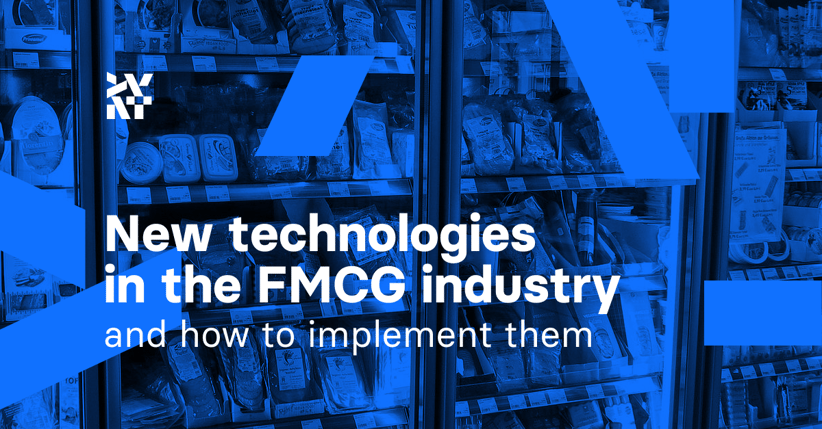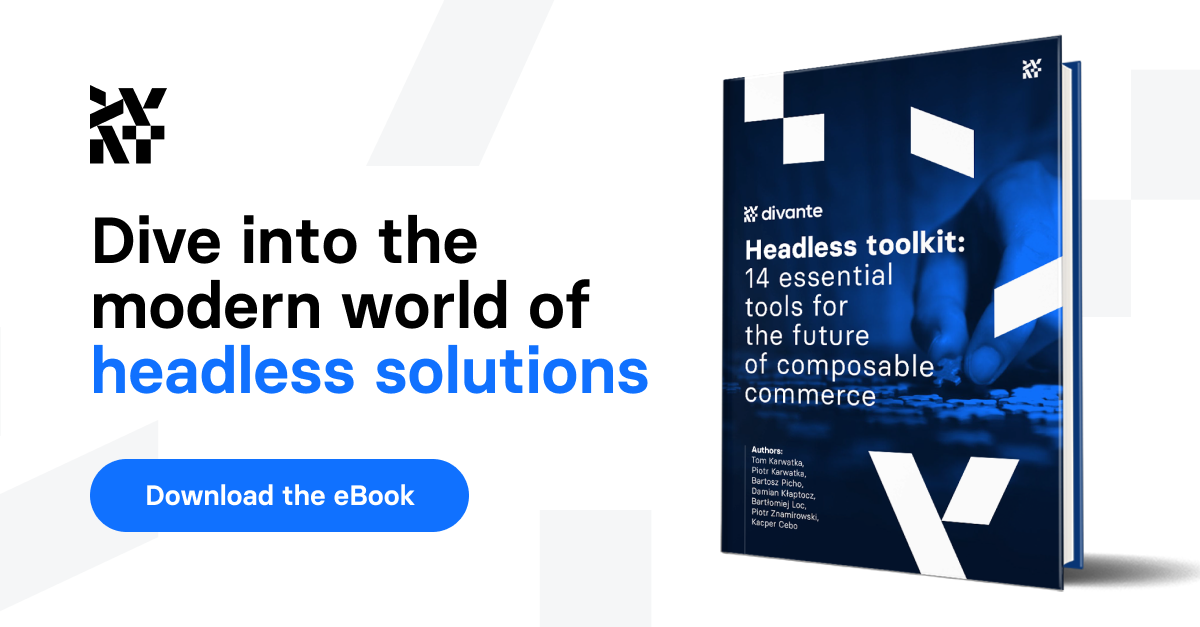Technology ages like milk. Simply put, they don’t age well. That’s why the fast-moving consumer goods (FMCG) industry is at the forefront of innovation by discovering new solutions and applying them in business. All across the market, we can see examples of digital transformation aiming to optimize business and outmaneuver the competition.
You can benefit from applying new technologies on multiple levels in your organization. Modern software solutions solve not only issues with keeping “fast” relevant in the FMCG acronym but also improve logistics, optimize processes, and drive sales.
Looking for new technologies, your ears will be filled with buzzwords like blockchain, artificial intelligence (AI), and big data. While some of them are just that, others can provide you with real benefits. Here are a few examples of trends. Let’s give them a quick reality check.
Connecting the dots and data with technology
Efficiency is the key to a profitable FMCG business. We fight not only against the expiration dates of products but also the complexity of production and administration processes. Proper automation is an investment that will result in optimizing costs and increasing your margin. There are a couple of things you need to know to get started on the right foot.
Unifying the tech stack within the group
Being in FMCG, you’re likely a part of a bigger group or have subsidiaries that use their own range of solutions. While you can probably connect them to keep the group working together for a time, in the long run, you’ll be looking to unify the technological stack to cut costs and improve transparency. It’s crucial to get it right since the costs of a failed implementation can go into millions of dollars.
It’s difficult to generalize this issue because the needs are unique for every company. You need precisely chosen, specific tech, elaborate architecture, proper methodology, and a sound transition plan. At the business and technological pace we experience today, we know one thing for sure: your architecture has to be agile.
What makes a modern FMCG IT architecture good?
The issues we usually see FMCG companies struggling with are the lack of process automation within their enterprise resource planning (ERP) and eCommerce systems. Employees have to click through all the digital paperwork. Orders aren’t automatically handed over to the warehouse management system. Customer service is manual when it can be automated through chatbots with benefits for both customer and producer.
To allow your company to automate those processes, you’ll need solutions that can be connected behind the scene. They need flexible APIs to let them communicate with each other without human help. The new approach to business software architecture leverages this approach to build solutions that are:
- split into microservices to easily manage all the features.
- focused on API interactions.
- cloud-based to keep your solution safe and scalable.
- decoupled from the front end that presents data to the users.
In short, it’s microservices-based, API-first, cloud-native, and headless. We call it MACH architecture. With this approach in mind, you get a constellation of independent software pieces that can be easily adjusted to your current needs, quickly rearranged, and seamlessly replaced if needed. To learn more about composable commerce and headless architecture, check out our headless toolkit.
Trends and technologies in FMCG
Omnichannel
In B2C, Omnichannel means the approach of allowing users to buy through any medium they want. They can access your products through voice assistants, mobile, desktop, marketplaces, and so on. In general, it’s an agile approach to sales channels and building architecture can be easily extended to the new touch points. In the near future, even a fridge might be able to restock on cheese if it runs out.
While omnichannel is praised in retail, there are no reasons not to use it in wholesale, too. In B2B, this means a flexible API that’ll allows your partners to plug in their systems and automatically place orders to control their stock. There might be new channels coming into play, and ones that we wouldn’t think of right now. With an omnichannel approach, you’ll be ready for that.
Marketplaces
Marketplaces are important for the industry because they can solve one of the most common issues. That’s the low diversification of sales channels. Solving this issue helps to scale your sales channels while keeping costs low.
If you put up your products online, you must take extra care for integrations with platforms such as Amazon. With modern eCommerce platforms, you can easily integrate with any external marketplace or build one for yourself. You can read more about it in our eBook about online marketplaces, this blog post about different types of marketplaces, or in this article listing great marketplace features.
Direct distribution/direct to consumer
Avoiding intermediaries in selling your products makes a lot of sense. It allows you to:
- connect with customers directly.
- build customer loyalty.
- engage with customers.
- increase your profit margin.
In the age of eCommerce, this trend for producers is even easier to jump on. You need to build your own online shop. That takes us directly to the next point.
eCommerce systems
Some modern solutions still struggle to adapt in many FMCG companies. Many eCommerce platforms lack basic eCommerce features, such as quick price updates on the website. It’s a crucial moment to get it right because the competition that already did it properly may start to further distance themselves soon.
“It’s forecasted that, by 2040, 95% of retail purchases are likely to be made online and traditional retail may hardly matter. Since using eCommerce has become a daily practice around the world, it's not surprising that consumers are now expecting a similar level of experience in B2B. Retailers who don’t transform to meet these demands are facing the risk of losing relevance with their customers.”
Olga Siemczonek, UX Researcher at Divante
eCommerce systems are a vast topic because they come in all shapes and sizes. We usually recommend Magento Commerce if your budget is smaller and commercetools if it’s bigger. There are many more rules, vendors, and hacks to make your system fit your company like a glove. Check out some of our eBooks on eCommerce to explore it further.
Optimizing supply chain management
When we’re talking about the supply chain in FMCG, we often mean third-party logistics (3PL). It’s not uncommon to see IT systems poorly integrated with 3PL. It may cause multiple issues, including:
- no possibility of canceling an order before it has been processed.
- no ability to quickly identify products that often break during shipment.
- difficulties with providing special packaging or specific warehousing and shipping conditions.
All these issues tend to be a nightmare without flexible tech to support your 3PL and might require custom integrations. Still, it’s good to get it right since it might open the way to a smooth international expansion.
“Fulfillment and logistics are make-or-break factors in international expansion. (...) The best way to provide low-cost, fast shipping to a consistent international customer base is to keep portions of your inventory in local fulfillment centers near them. Look for 3PL based in your country that has an international warehouse network.”
Katie-Jay Simmons, retail and eCommerce expert at Fit Small Business
AI
One of the most misunderstood innovations in modern technology, AI can provide you multiple benefits ranging from automating customer service to improving process automation. Within the FMCG industry, the most interesting area will be big data analysis. It can analyze a database to find patterns, discover interesting dependencies, optimize budgeting, and predict trends.
Blockchain solutions
Blockchain has been a big buzzword for the last decade. Except for crypto payments, there are two particularly interesting use cases for the FMCG industry:
- Bringing transparency to the supply chain and certifying products, as in the Walmart case study.
- Building blockchain-based loyalty programs.
Custom or out-of-box
They say that with modern technologies, the possibilities are endless, but in fact, we’re all limited by budgets and timelines. Time is the trade-off for FMCG companies whenever we build IT systems to last.
When picking the right technology in a big FMCG company, you face the build vs buy dilemma. You can develop solutions from scratch, or you can apply out-of-box applications to solve your problems. In practice, usually, the most efficient project will be combining both approaches: you build custom features over a set of integrated out-of-box solutions.
If you want to dig deeper into the possibilities and technologies used in modern FMCG businesses, feel free to contact us or simply continue to discover our comprehensive library of eBooks, webinars, and podcasts.
Published June 17, 2022













